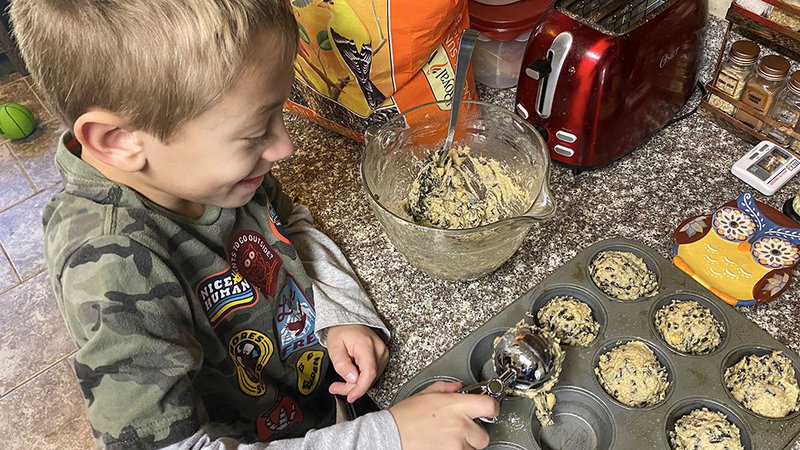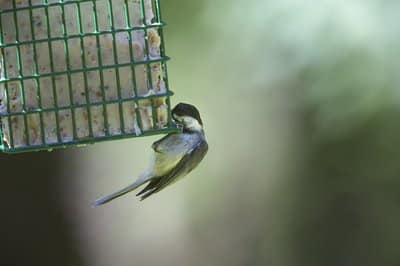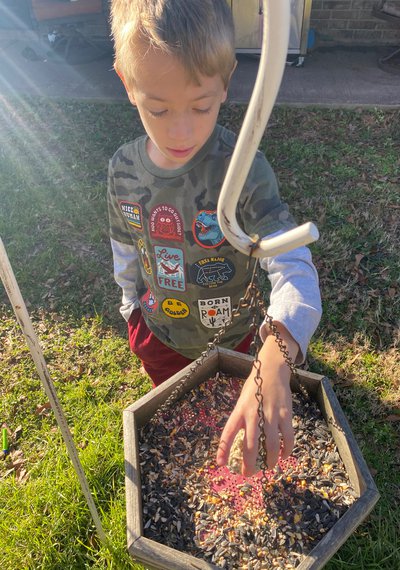Simple recipe to share with your feathered friends
ON 01-26-2022

Jan. 26, 2022
Randy Zellers
Assistant Chief of Communications
LITTLE ROCK — Hollie Sanders, AGFC assistant chief of education, is known for teaching people how to cook up delicious Dutch Oven recipes, but one of her favorite treats to cook isn’t something you’d look forward to having on your plate, unless you happen to be one of the millions of birds that call Arkansas home.
Bird suet is a combination of fat, nuts, fruits and grains that remains solid so that birds must work to peck out a piece of their choosing. Instead of spilling loose, treats embedded in the block of fat are left behind until a bird claims them. The fat itself also offers a boost of energy to help avian species stay in good physical condition when insects and other sources of food are scarce.
“Some of the ingredients in suet cakes actually sound pretty good, but then you get to things like lard and mealworms and it reminds you that it’s for the birds,” Sanders said.
Suet cakes will attract many seed-eating birds that frequent other feeder styles, but also are particularly good at drawing in woodpeckers, nuthatches, chickadees and even warblers, depending on the ingredients mixed in the cake.
Suet feeders have a few other benefits over traditional seed feeders. They typically don’t create a mess of seed hulls underneath the feeder, and tend to stay cleaner because birds are able to grab the mesh of the feeder instead of perching on a flat post that can collect droppings.
Sanders’ favorite recipe for suet cakes comes from Katherine Becker, a central Arkansas master naturalist and a volunteer who has worked with the Witt Stephens Jr. Central Arkansas Nature Center for years.
“She would make this suet and donate it to the center for the bird-viewing area, and the birds absolutely loved it,” Sanders said. “She also joined me in making suet for a few classes.”
The best part about suet feeders is the added fun of preparing the food with family and friends. It’s a great hands-on activity that younger birdwatchers can enjoy and make a connection with the outdoors, wherever they live.
“One of my favorite classes when I was at the center was when Katherine and I made this suet for a group of pre-K kids that would meet weekly at the center to learn about nature and wildlife,” Sanders said. “It’s a fun winter time activity that connects people with wildlife in their own backyard. Since my grandson was a toddler we have made suet together every year because I know that learning to care about wildlife starts at the beginning; when you are a child.”
Sanders says suet recipes are like chili recipes; everyone has their own version, so don’t be afraid to experiment. Different recipes may attract different bird species depending on what you put in it. To make a simple suet you will need some type of fat, a nut butter, some dry mix like oatmeal, cornmeal, and flour, and then the fillers such as wild birdseed and dried fruit.
The ingredients are mixed together and scooped into a mold.
“I use a muffin tin to make small cakes or I have also repurposed a suet container that previously held a suet cake purchased from the store,” Sanders said. “Freeze the cakes until solid and then they are ready to be placed outside. You can even place a piece of yarn or string in the mold before it solidifies if you want to hang the suet by itself without a feeder.”
Simple Suet Recipe
● 1 cup suet: lard, vegetable shortening, or meat fat
● 1 cup smooth or crunchy nut butter (peanut, almond, sunflower, etc.)
● ½ cup dry oatmeal
● ½ cup cornmeal
● ½ cup flour
● Fillers: raisins or dried fruit, nuts, wild bird seed, flaxseed, mealworms (whatever birdy type food you have in your pantry)
Melt the lard or shortening in a microwave (about 45 seconds) or on the stove top. Stir in the nut butter (the warm suet will soften the nut butter). Add oatmeal, cornmeal and flour. Mix in fillers until the suet has a good texture where it can be scooped. Distribute the mix into containers to mold (muffin tins work great). If you are going to hang a cake on its own, stuff a piece of twine or yarn into the mold and ensure it is covered with mix. Place in freezer for two hours. Pop suet cakes out of mold (warm the outside of the mold slightly if cakes are stuck). Store in a refrigerator or freezer until ready to use.
Recent News

CWD-positive deer found in Grant, Sevier counties
Dec. 19, 2025

Arkansas Wildlife Weekly Fishing Report
Dec. 18, 2025
Subscribe to Our Weekly Newsletter E-mails
Don’t miss another issue. Sign up now to receive the AGFC Wildlife Weekly Newsletter in your mailbox every Wednesday afternoon (Waterfowl Reports are published weekly during waterfowl season and periodically outside the season). Fishing Reports arrive on Thursdays. Fill in the following fields and hit submit. Thanks, and welcome!
